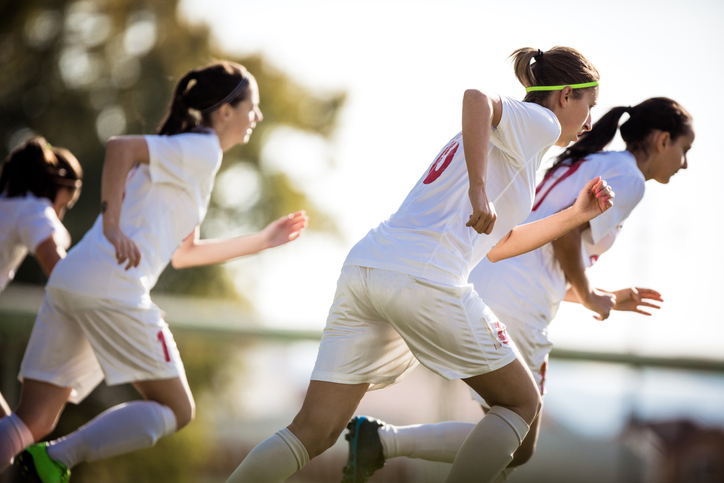By Dr. Kristina DeMatas
To prepare each student for the fall sports season in the US, a medical professional must carry out a preparticipation physical evaluation (PPE). This ensures that young athletes are medically able to engage in sports and have a good current health status. The PPE is guided by the following organizations:
- American Academy of Family Physicians
- American Academy of Pediatrics
- American College of Sports Medicine
- American Medical Society for Sports Medicine
- American Orthopaedic Society for Sports Medicine
- American Osteopathic Academy of Sports Medicine
Fall sports season activities and common injuries incurred as a result of participation
Students take on many different types of fall sports. Although the exact fall sports roster may vary depending on where you are located. Here is a list of the common sports taking place during the fall:
- Soccer
- Football
- Cross Country
- Tennis
- Volleyball
- Golf
- Field Hockey
- Cheerleading
With all of these fall sports, there is a chance of injury. Medical practitioners need to be ready to address some or all of the following common sports injuries:
- Concussion
- ACL Tear or Strain
- Ankle Sprain
- Back Overuse
- Stress Fractures
- Groin Pull
- Hamstring Strain
- Heat & Dehydration
- Hip Flexor Strain
- Jumper’s Knee
- Little Leaguer’s Elbow
- Patellofemoral Syndrome
- Plantar Fasciitis
- Runner’s Knee
- Sciatica
- Shin Splints
- Shoulder Injury
- Tennis/Golf Elbow
- Wrist Injury
Competency areas of medical professionals to help young athletes
To prepare adolescents to engage in fall sports, above and beyond filling out a sports physical form, a medical professional should be clinically competent in the following areas:
- Rehabilitation/Return to Activity: Rehabilitation of athletes who suffer from impairments, functional limitations or disabilities with a focus on returning to the sporting activity of their choice.
- Acute Injury/Illness Management: Ability to address and manage the acute injury or illness associated with the sports activity.
- Sports Science: Maximizing the athlete’s performance with training in mind, as well as the effects of nutrition and environment on the performance.
- Medical/Surgical Considerations: Taking care of the medical and surgical considerations of athletes.
- Injury Prevention: Offering injury and disease prevention for athletes.
- Critical Inquiry: Maintaining the current knowledge and applying the principles of evidence-based practice relating to sports physical therapy and contributing to the relative body of knowledge.
What should a proper sports physical for fall sports should cover?
The first portion of the PPE is a review of medical and family history. This portion of the evaluation is important to determine if the student athlete has a personal history of any medical conditions or has a family history of specific medical conditions. This portion of the PPE includes reviewing the following:
- Personal history: Chest pain, fatigue, murmurs, syncope, blood pressure, shortness of breath with exercise
- Family history: Premature death (before the age of 50), heart disease and cardiac conditions, and sickle cell disease
Additional questions which must be asked include medication and supplement use, nutritional status, screening of heat-related risk factors, concussion history, and, for women, menstrual history.
The physical examination
The physical examination consists of a general health screen, cardiovascular screen, neurologic screen, orthopaedic screen, and general medical screen. Each of these screening items will have specific areas to address and consist of the following tests/evaluations:
- General Health Screen: Vital signs, weight, height, vision testing, pulmonary, neurological, blood pressure, abdominal, skin and genitalia exam
- Neurologic Screen: Concussion history, spinal cord injury, sensory/reflex/motor control testing, seizure disorder, and cervical spinal stenosis
- Cardiovascular Screen: Marfan syndrome characteristics, heart murmurs, femoral pulses, auscultation of the heart (seated/standing), blood pressure
- Orthopaedic Screen: Musculoskeletal screening of previous/current injuries, range of motion, site specific examination of strength, deformity, and asymmetries
- General Medical Screen: Anemia and low ferritin levels, symptoms/signs of diabetes, and previous history of diabetes
At some point during the preparticipation physical evaluation, the medical professional should point out the importance of hydration and a healthy diet. Athletes themselves must keep up with their sport-specific workouts during the offseason and preseason to ensure that their bodies are prepared and acclimatized to the demands of the sport they play.
***
Dr. Kristina DeMatas is a family and sport medicine Physician at Mayo Clinic in Jacksonville, Florida. She is also the founder of Sporty Doctor, where she shares tips on nutrition and rehabilitation.
